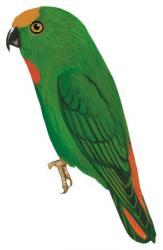Content
|
|---|
Description
It measures each 11 cm.. length and a weight between 13 and 16 g..
The head of the Orange-fronted hanging parrot (Loriculus aurantiifrons) is green, with the front of the crown yellow (sharp demarcation of the green in the crown rear). Upperparts green, with rump and uppertail-coverts bright red; sides rump with yellow marks. Wings Greens with vane internal to the flight feather blackish. Blue with green Underwing coverts. Chin red, rest of the underparts are slightly more yellowish than upperparts (especially coverts). Timoneras pens Green with tips yellow; undertail bluish.
Bill black; Iris whitish; legs brownish black.
Female has the face and the part front of it crown Green with red and pale blue feathers. Spada Red more small that it's the male. Iris brown.
The young birds lack of the crown and throat red. Bill brown.
Description 3 subspecies
-
Loriculus aurantiifrons aurantiifrons
(Schlegel, 1871) – Nominal
-
Loriculus aurantiifrons batavorum
(Stresemann, 1913) – Male with less yellow in forecrown. Female similar to nominal.
-
Loriculus aurantiifrons meeki
(Hartert, 1895) – The male as of the subspecies batavorum but slightly larger. Female also similar to nominal but larger and bases of feathers on the front of the crown, yellow-brown color.
Habitat:
The Orange-fronted hanging parrot they are distributed in the low jungle to a altitude approximate of 1.200 m (from time to time to 1.000 m), along the edges of forests, in palm plantations, areas of secondary growth, casuarinas, pines, gardens and partially cleared areas.
The species is inconspicuous and usually difficult to detect, except when they are called among them, Since it flies above the canopy. It is usually found in groups of two to four members, foraging at various levels in the forest.
Birds perch on occasions in a branch and sing (possibly part of their courtship behavior).
Reproduction:
Guidelines of nesting you have registered between July and October, and it is said that on one occasion a bird was found incubating four eggs in a hole to 12 meters above the ground. The birds have also been observed visiting holes in arboreal termite, perhaps to rest.
Food:
Is them has observed entering their peak next to the needles of casuarinas, probably in search of Lerp insects. The diet also includes outbreaks, fruits and flowers.
Distribution:
Size of the area of distribution (reproduction / resident): 576.000 km2
Widely distributed, Although not particularly continuously, through much of the lowlands of New Guinea, in both Irian Java, Indonesian, and Papua New Guinea, Although it can be absent from most of the Center-South of the big island.
Its small size, coloration and habits make difficult his observation. Field work are running that the species is continuing in the North and South of New Guinea with the clinal variation in size. The range includes the following islands of the coast: Misool, Waigeo, Karkar, Fergusson and Goodenough.
Distribution 3 subspecies:
-
Loriculus aurantiifrons aurantiifrons
Nominal.
-
Loriculus aurantiifrons batavorum
Waigeu, West of the papua islands, and Northwest of New Guinea, East Coast region North of Sepik River, North of Papua New Guinea, and the South coast of Setekwa River, Irian Jaya.
-
Loriculus aurantiifrons meeki
Fergusson, Goodenough, Karkar Islands (Papua New Guinea), and this from New Guinea, from the coast north to the West of the region of Sepik River, and in the South West area of lowland up to the region of Fly River, and possibly in the vicinity of Irian Jaya.
Conservation:
• Current IUCN Red List category: Least concern.
• Population trend: Stable.
The world population of the Orange-fronted hanging parrot It has not been quantified, Although it is suspected that it may be most of 100.000 specimens and are considered stable and locally common (pit et to the. 1997).
The population is suspected to be stable in the absence of evidence of any reduction or substantial threats.
"Orange-fronted hanging parrot" in captivity:
extremely rare.
Alternative names:
– Orange-fronted Hanging-Parrot, Bat Lorikeet, Golden-fronted Hanging-Parrot, Misool Hanging-Parrot, Orange fronted Hanging Parrot, Orange-fronted Hanging Parrot, Papuan Hanging Parrot, Papuan Hanging-Parrot (ingles).
– Coryllis à front orange (French).
– Goldstirnpapageichen, Grünstirnpapag (German).
– Lorículo Papú (español).
scientific classification:

– Order: Psittaciformes
– Family: Psittaculidae
– Genus: Loriculus
– Scientific name: Loriculus aurantiifrons
– Citation: Schlegel, 1871
– Protonimo: Loriculus aurantiifrons
Images "Orange-fronted hanging parrot"
“Orange-fronted hanging parrot” (Loriculus aurantiifrons)
Sources:
Avibase
Parrots of the World – Forshaw Joseph M
Parrots A Guide to the Parrots of the World – Tony Juniper & Mike Parr
Birdlife
Photos:
(1) – Rockjumper
(2) – hbw



